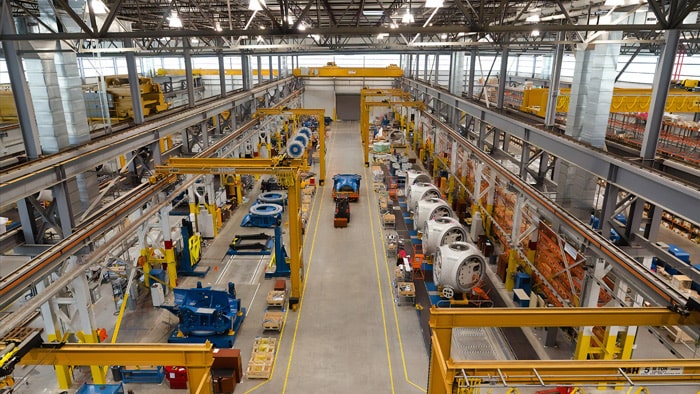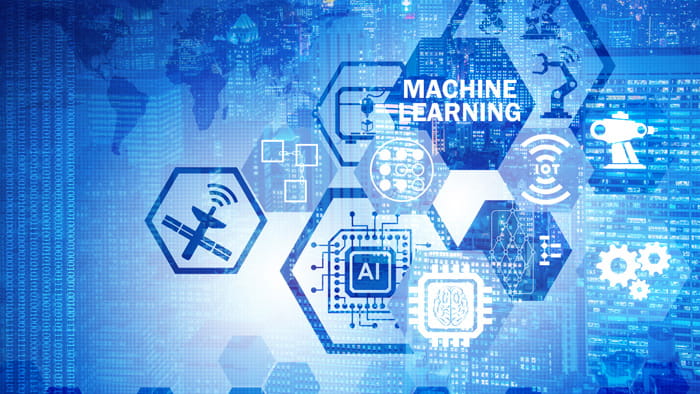Time to read: 12 min

What is a macro trend? While a trend is a general shift toward a specific thing, a macro trend is a persistent and widespread shift on a global scale. Examples include urbanization, automation, and globalization. It’s much longer-lasting than a fad and tends to change national or global culture and practices.
Policymakers and manufacturers need to understand macro trends and their dynamics to adjust their processes and strategies. Manufacturing trends, including increased productivity in the face of rising costs and new production processes spurred on by material innovation, all stem from these global shifts.
Why Macro Trends Matter
Macro trends matter because new manufacturing trends come with new risks and uncertainty. New trends generate:
- Demand volatility
- Capital cost uncertainty, currency fluctuations, and commodity price volatility
- Supply chain risks and location-specific risks
- Talent shortages
- Effects of government policies supporting and fostering domestic manufacturing
Organizations have already experienced the challenges presented by current macro trends with global consumer and business demand shifting towards developing economies. Companies are designing more customized products to meet customer demand. Value-added services continue to grow, and low-cost locations are seeing a rise in wages.
Macro Trends in Manufacturing To Pay Attention to Today
Several macro trends are already exerting their influence over the manufacturing industry, and future macro trends are already in the wind. Here are ten macro trends that are growing momentum and figure into the future of all manufacturing.
1. Industry 5.0, IoT, and Blockchain —The Trio That Digitized the Manufacturing Supply Chain

Taken together, Industry 5.0, blockchain, and IoT bring technology to the forefront of manufacturing. Where some companies have charged ahead with automation and other process changes, many others have hung behind to see where these macro trends will lead.
Now, though, there is no more time to wait and see where these innovations will take the manufacturing industry before hopping on the train.
Industry 5.0
The speed with which industry continues to change takes many by surprise. It wasn’t that long ago people were talking about Industry 4.0. Where the previous iteration focused on the interconnectivity of systems and machines to help optimize performance and create efficiency, Industry 5.0 seeks to put the human element back into manufacturing.
Industry 5.0 refers to humans working alongside automation. It’s about robots and automation helping people work better and faster by leveraging advanced technology such as big data and IoT.
Where Industry 4.0 was all about the pillars of automation and efficiency, Industry 5.0 adds the human touch and a more personal aesthetic to manufacturing. By merging cognitive computing capabilities with human intelligence and resourcefulness, you can achieve higher levels of collaboration and efficiency than ever before.
Industry 5.0 is not about superseding humans on the manufacturing floor. It’s about supporting humans and optimizing the balance between efficiency and productivity
IoT in Manufacturing
With increased connectivity, manufacturing firms can gather more data and analyze it to improve insights and enable change, optimization, and process improvement. The Internet of Things (IoT) in manufacturing — sometimes called the industrial internet of things or IIoT — enables companies to connect and monitor a multitude of operational components.
IIoT makes use of smart sensors and cloud computing to allow equipment and systems to communicate with one another over the internet. Using IIoT, manufacturers can improve safety, cut costs, increase efficiency, and boost new product development.
The IIoT market is expected to be worth US$110.6 billion by 2025, with manufacturing being a key driver of growth. Across the entire IoT industry, there has been more than twice as much IoT investment in the manufacturing industry as there has been in smart homes or production asset management.
Blockchain
A blockchain collects information together in groups, also known as blocks, that hold sets of information. Blocks have certain storage capacities and, when filled, are chained onto the previously filled block, forming a chain of data known as the “blockchain.”
When it comes to manufacturing, blockchain has allowed for seamless aggregation of all information, delivering significant value for industries and companies. Blockchain also helps businesses utilize the full potential of other advanced technologies like IoT, 3D printing, and augmented reality
Blockchain increases supply chain transparency tracks the credentials and identities of key personnel, and optimizes audits and regulatory compliance functionality. It enhances track-and-trace and protects and monetizes critical intellectual property. Blockchain also simplifies and protects quality checks, advances machines as a service, and enables machine-controlled maintenance.
For manufacturers, blockchain increases visibility across every process, from supply and procurement to strategic sourcing and supplier quality. Shop floor operations, including machine-level monitoring and service, can gain from blockchain’s distributed ledger structure and block-based approach to efficiently aggregating value-exchange transactions.
In a 2018 PwC survey, respondents ranked industrial manufacturing firms as second among industries leading the way with blockchain.
Industry 5.0 is on its way, and IoT and blockchain technology support it.
2. Machine Learning and AI

Machine learning and AI provide three fundamental values for manufacturing: scale, speed, and convenience. The fundamentals of speed and scale refer to a manufacturer’s ability to automate industrial functions without assigning a group of employees to designated tasks. The company achieves a reduction in the time invested in a variety of jobs.
Machine learning uses computer systems capable of acquiring knowledge and adapting to circumstances without following explicit instructions. It puts algorithms and statistical models to use to analyze and draw inferences from patterns in data. AI (artificial intelligence) allows computer systems to recognize trends and infer logical conclusions in order to enable data-driven decision-making.
With the enhanced logic capabilities of machine learning and AI, manufacturers can improve operations across an entire enterprise. The following processes are especially compatible:
- Supply chain and logistics
- Inventory management
- Asset tracking
- Warehouse budgeting
- Transportation budgeting
- Forecasting
AI and machine learning are poised to do so much more for manufacturing in the future. With them comes improved efficiency and elevated profit margins.
3. Value Stream Transformation
Value stream transformation is a crucial tool for transforming and aligning manufacturing with post-COVID-19 expectations. Value stream transformation is a systematic approach aimed at achieving sustainable improvements throughout a company while developing a continuous improvement culture.
During the pandemic, companies raced to the cloud. According to the Flexera 2020 State of the Cloud Report:
- 59% expected cloud usage to exceed their initial plans
- 61% planned to focus on cloud migration
- 83% cited security as a top cloud challenge
- 82% cited cost as a top cloud challenge
COVID-19 increased interest in IoT technology for remote monitoring and predictive maintenance capabilities. Manufacturing firms are now hoping to move into a post-COVID world using the lessons learned to transform their value stream.
There are three critical steps needed to move value stream transformation forward after the pandemic:
- Respond: Companies must take immediate actions to promote safety and essential business operations.
- Recover: Companies must restart activities such as opening, hiring, budgeting, and supplying as well as making a plan to restore a scalable state.
- Renew: Companies should take lessons and emergent patterns from the first two steps to develop a new foundation.
Manufacturing firms need to strategically execute all of these processes in order to ensure a successful transformation.
4. Manufacturing on Demand (MOD)
Manufacturing on demand, or MOD, is all about producing only what customers need when they need it. With this technology, there’s no more manufacturing vast quantities of the same thing and storing it in inventory until someone buys it.
Using cloud technology and a digital self-service platform, customers obtain quotes for parts in real time and stay connected to the order production process through to delivery. They order precisely the quantity needed for their requirements, leveraging JIT (just in time) manufacturing to its fullest extent.
Platforms like the Digital Manufacturing Ecosystem at China Manufacturing parts, Inc. enable MOD with industry-first features for visibility, speed, traceability, and quality. Customers can use it to order custom mechanical parts for both prototyping and production. The platform fits in with work-from-home requirements and responds to compressed product introduction timelines.
MOD customers benefit from on-demand production status updates, centralized access to design files, historical DFM, and other features that streamline manufacturing while saving on materials and storage. All of the data for an order is in one place, and the customer can get expert guidance if needed.
The impact of MOD to enterprise customers ordering and tracking hundreds of parts at once is tremendous. 24/7 visibility and transparency and access to a real-time schedule keep everything moving efficiently. With the use of CNC machining, customers can obtain complex, high-precision mechanical parts at 100 times the speed and one-tenth the cost compared to traditional manufacturing.
5. IoT-Enabled In-Plant Automation

IoT-enabled in-plant automation is another way of referring to the interconnection of devices within an existing infrastructure. Connectivity enables manufacturing to reduce costs, enhance efficiency, improve safety, and innovate.
A growing number of production processes are beginning to leverage smart devices and embedded intelligence. While not all firms have adopted these technologies across the board, many manufacturers are making plans to embed IoT into their products or processes. Along with predictive analytics, IoT technology offers new ways to connect businesses and improve processes.
Manufacturing accrues a raft of benefits from IoT-enabled automation, including:
- Improved inventory management
- Upgraded supply chain visibility
- Enhanced product quality controls
- More real-time insights
- Increased cost savings
- Better asset security
Companies see increased revenue and an improved supply chain with asset interconnectivity. Organizations can anticipate the market, monitor assets, and mitigate unplanned shutdowns with predictive maintenance.
6. Picking Automation Using Cobots
A cobot is a collaborative robot designed to allow robots and humans to work together. Using cobots, organizations get more work done faster and safer while reducing repetitive tasks for employees.
Cobots built for the human workforce are valuable tools for improving overall manufacturing efficiency and safety. One of the most common uses is picking in a logistics setting. Simple walking time actually accounts for half of the time it takes to pick a product, a problem that can easily be solved by automation.
AMRs, (autonomous mobile robots) are tailored for partnership with people. They are programmed to consistently perform non-value-added tasks like moving heavy products, freeing up humans to provide more skilled labor.
In automated picking, a robot is used to travel throughout a warehouse to pick the correct product. Employees then perform the rest of the fulfillment process.
Compare the number of orders per hour a human can pick in comparison to a robot. A human can pick between 60 and 80 orders per hour. A cobot picks up to 300 orders an hour.
Often, automated picking can also introduce a higher level of accuracy into the process.
7. Integrated Planning Through ERP
ERP (enterprise resource planning) includes demand planning, inventory planning, distribution planning, and RM and RG planning. ERP is a cloud-based solution that is easy to deploy and affordable for small businesses.
ERP tools help manufacturers automate all operations using a single system. Universal touchpoints provide exceptional manufacturing insight over an entire operation. These tools help companies find and expedite improvements and adjustments when they are needed.
More and more manufacturers are layering agile applications on top of their existing ERP solutions instead of using the ERP tools for all of their tasks. Typically, data drives ERP upgrades, enabling manufacturers to move data forward and consolidate it around modern data platforms. Using ERP software as part of this process results in a faster time-to-value.
Manufacturers are also able to build tangent functions atop existing data models without requiring a total replacement of the ERP or making substantial updates to it.
8. Sustainability — Manufacturing’s Role in Planet, People, and Profits

Sustainability is a supporting component of today’s overall environmental preservation trends. Working on sustainability in processes allows manufacturers to help sustain a stable level of natural resources rather than depleting them.
Efforts in sustainability mean paper manufacturers are obtaining wood from forests that are continually replanted. They mean recycling and reusing oil, plastics, and glass.
The primary drivers of sustainability in manufacturing include:
- Improvements in energy productivity
- Reductions in greenhouse gas emissions
- Favorable perception of the company from investors and consumers
Sustainability is a market driver because people increasingly desire environmentally sustainable products and practices.
Improvements in sustainable practices are critical in the production of energy-intensive commodities like aluminum and cement, where energy costs can be 20% of total landed costs. The steel, chemical, and refined products industries face regulatory pressure to become more sustainable because they contribute up to 60% of the manufacturing sector’s CO2 emissions.
The trend toward greater energy productivity is encouraging energy producers to change their mix of energy inputs from coal to cleaner fossil fuels or renewables. The transformation includes upgrading to newer technology, more efficient processes, and changing the materials mix to reduce emissions
9. Agile Supply Chains
Supply chains are trending toward high-mix, low-volume (HMLV) manufacturing. In these cases, organizations need effective supply chain management to save costs while still being able to deliver products when and how the customer wants them.
The agile supply chain refers to the use of responsiveness, competency, flexibility, and quickness to manage daily supply chain operations using real-time data and updated information. Agile supply chain technology impacts everything — procurement, inventory, assembly, logistics, transportation, and sales.
One way manufacturers meet the real-time data challenge presented by agile operations is by adding sensors or barcodes to items for scanning and tracking throughout the manufacturing the process. Monitoring the process helps find and eliminate bottlenecks and other problems that cause manufacturing delays.
10. 3D Printing, a.k.a Additive Manufacturing
Additive manufacturing is the official term for 3D printing, a technology that uses CAD (computer-aided design) software to build custom parts and products a layer at a time.
Additive manufacturing isn’t just for generating complete products. It’s also useful for modeling, prototyping, building molds, performing investment casting, or manufacturing components for a final finished piece.
3D printing provides significant cost and time savings, and its use is growing at an accelerated rate. Metal fabricators and manufacturers that deal with metal components are heavy users of the technology.
Additive manufacturing enables cost-effective production of metal parts that, in the past, were thought to be impossible to make. For example, selective sintering technology, an additive manufacturing technique that uses a laser as the power source to sinter powdered material, lets companies build metal products in-house, eliminate tooling costs, and significantly reduce development time. It opens up greater flexibility in shapes and materials while speeding up production and cutting costs.
Additive manufacturing is expected to grow to $23 billion by 2026.
Future Trends and Growth Projections

Emerging macro trends involve a re-evaluation of offshoring and the outsourcing of materials. However, the current uncertain job market due to the global pandemic is adding volatility unseen since the Great Recession. Other technologies on pace to disrupt and change manufacturing include 5G and mobility-as-a-service.
Reshoring
While offshoring was once a widely-used technique for creating cost savings, many companies are now reshoring production and manufacturing. In an effort to avoid supply disruptions and provide more domestic jobs, they are bringing formerly imported goods and materials back to domestic production.
The biggest driver of reshoring is cost. Many of the countries where organizations once offshored their work have become more economically developed in the past few decades. This newfound strength has led to demands for increased wages.
Countries where labor is still inexpensive often lack the infrastructure needed to support complex manufacturing operations. If labor is short domestically, manufacturers can use advanced software and robotics to automate many of the processes that once required human employees to perform.
The cost of transportation is another driver as it continues to rise due to increases in fuel prices.
COVID-19
The most significant trend today is the disruption caused by the COVID-19 pandemic. COVID-19 has shaken up nearly every supply chain and manufacturing facility on the globe. Delays and shortages continue to ravage manufacturing’s ability to meet deadlines and keep products available.
Mass layoffs and furloughs caused by the pandemic have added to an already uncertain job market, but the impact has been uneven. Essential goods production has had to scale up, sometimes overnight, while non-essential manufacturing has reduced staff significantly. Manufacturers continue to re-evaluate their workforce based on demand shifts by consumers and clients.
Those manufacturers that are hiring are likely in the market for data-focused employees, who are in scarce supply. Non-essential manufacturing is choosing IoT automation and optimizing their product lines and factory processes to save money and maintain business.
5G
5G and smart manufacturing go hand in glove. With the growth in connectivity, bandwidth, capacity, and minimum latency, 5G is likely to outperform clients’ and companies’ expectations. 5G and smart manufacturing are both key features of universal digital transformation.
As companies increase cloud utilization, centralized tracking, and quality inspection, 5G is already in operation. Widespread coverage and a stable, reliable connection are contributing to the foundation of a smart manufacturing ecosystem.
Conclusion
In previous decades, manufacturing organizations appeared to be lagging in technological adoption and innovation, but that has changed significantly. Macro trends are now driving current and future improvements in manufacturing in ways never before seen. For each macro trend, technology and manufacturing have responded with newly built and improved processes that have cut costs, provided efficiencies, and helped to meet consumer and B2B demand.
A successful organization understands the implications of each macro trend as it appears and makes the necessary changes to continue growth. Many of the changes are already here and are set to expand manufacturing capabilities if companies successfully adopt them.
To learn more about the current trends in manufacturing and how to leverage them to promote growth, read China Manufacturing parts’s 2021 State of Manufacturing Report.